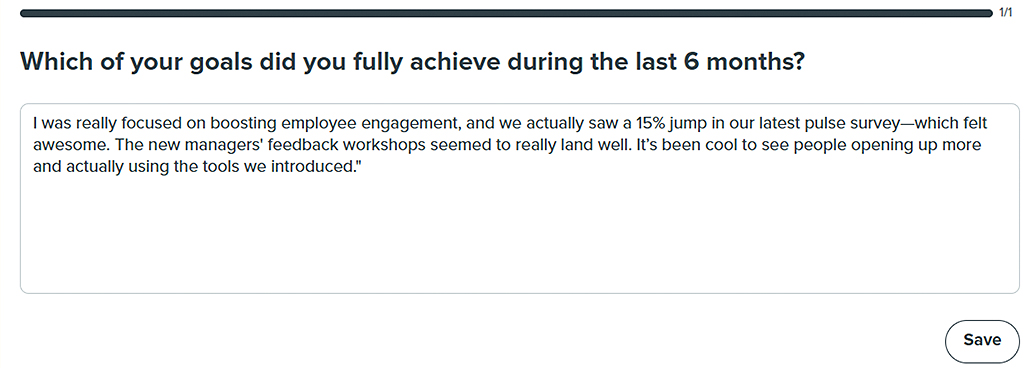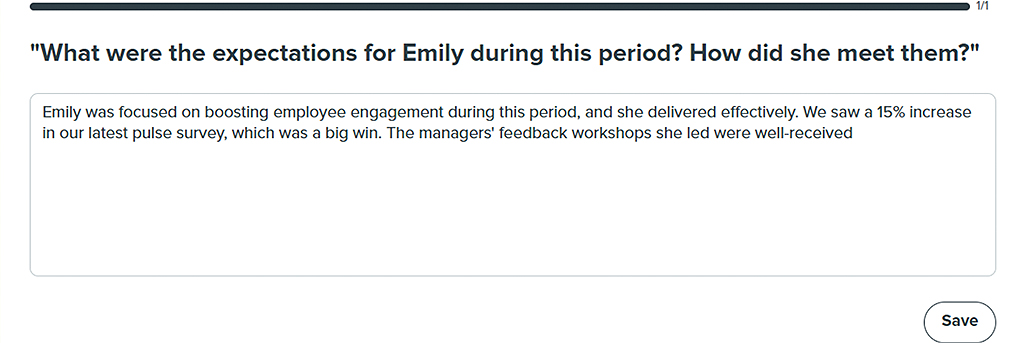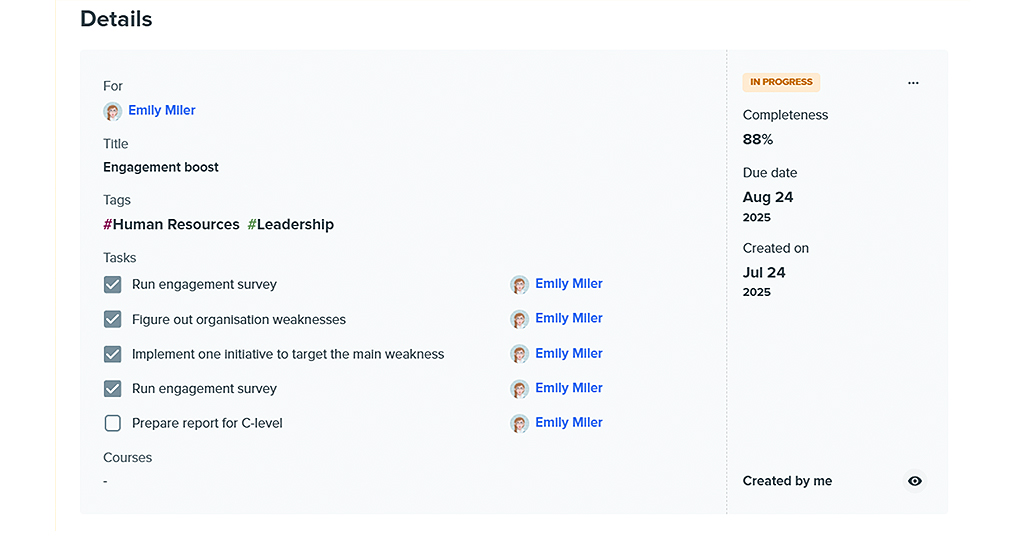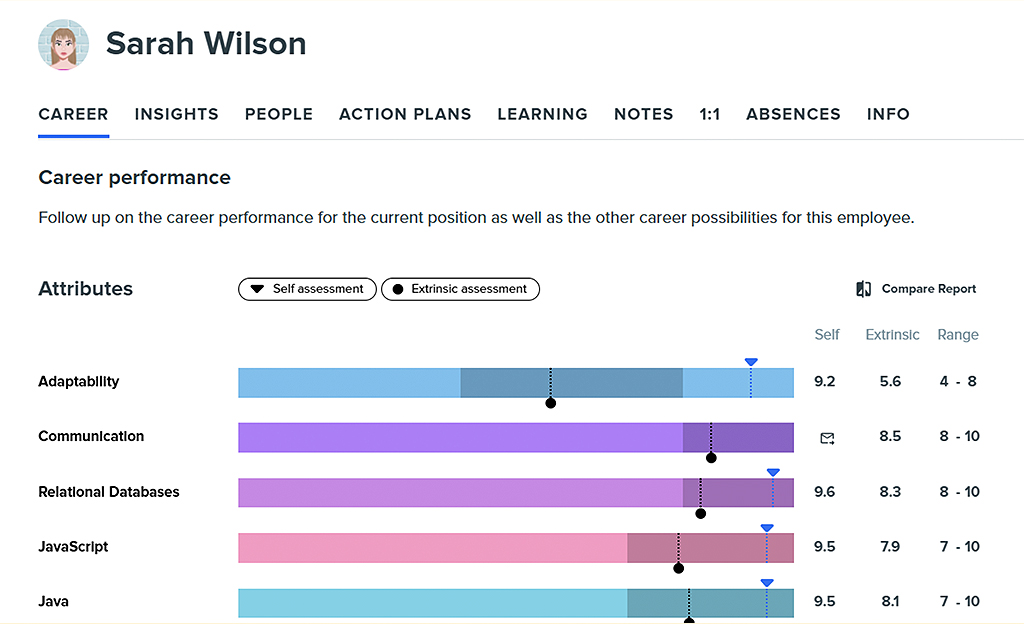Mid-year is here. The projects are moving, priorities have shifted, and someone on your team is quietly doing twice as much as they did in January.
And yet, when it’s time for the mid-year performance review, the same template gets pulled out. The one you used last year, with generic questions no one reads twice.
Most tech teams don’t lack good intent. They lack structure. And when reviews are rushed, copied from the last cycle, or treated as a formality, the chance to course-correct quietly slips by.
Done well, the mid-year review is a moment of clarity. Not a report, not a form, but a shared check-in on progress, blockers, and what needs to change before Q4 hits.
In this article, we’ll unpack what most teams get wrong, what a mid-year performance review should do, and how to make the most of it using a simple structure that’s built for fast-moving teams.
What most teams get wrong about the mid-year performance review
It’s easy to treat mid-year reviews like a lighter version of the annual one. The exact structure, just six months earlier. A few adjusted goals, a few vague comments, and everyone moves on.
But that’s precisely the problem.
Instead of becoming a chance to shift direction, reset expectations, or catch minor issues before they grow, mid-year reviews often turn into a missed opportunity.
They’re either rushed through in a week before summer vacations, or postponed so many times they end up happening in Q4. By then, it’s already too late to fix anything.
💡 According to Workhuman research, nearly one-third of employees are still reviewed only once a year and just 18% have bi-annual reviews.
It’s not a lighter version of the annual review
Mid-year is not just a checkpoint but a turning point. The value isn’t in summarizing the past, but in shaping what comes next.
When teams copy and paste the annual review format, they send the message that nothing changes mid-year. But for fast-moving tech teams, a lot does.
If someone’s role has evolved, if priorities have shifted, or if blockers have emerged, this is the moment to discuss it. Not six months from now.
It’s often too vague or too late
Generic review forms, last-minute scheduling, unclear questions… these are the usual suspects. They lead to conversations that feel superficial and leave people wondering if anything will change.
By the time someone realizes they’re off track or stuck in the same place they were six months ago, the damage is already done, and the momentum is lost.
💡 According to SelectSoftware Reviews, 71% of companies still rely on annual performance reviews only. In fast-moving teams, that leaves little to no room for course correction and often turns feedback into a formality.
What a mid-year performance review should actually do
Let’s forget the form for a moment. What’s the point of doing a mid-year review in the first place?
Is it just about tracking progress?
Not really. Tracking is useful, but that’s what dashboards are for. A review should zoom out and ask, “Are we heading in the right direction? Is the team aligned? Is anyone stuck or underutilized?”
Mid-year is the ideal moment to gather performance feedback that goes beyond task completion and reflects how someone is showing up across the team.
It’s a chance to step back from day-to-day delivery and look at the bigger picture for the team, and for each individual in it.
Should it focus on performance or potential?
Both, but with different purposes. Performance gives you a snapshot of how things have gone so far. Potential helps you adjust in the second half of the year.
Someone who had a rough Q1 might be in a better place to grow now. Mid-year is the moment to catch that before it gets lost in year-end summaries.
A good example of this in action is Asana’s performance management approach. The company holds performance reviews every six months, but reinforces them with structured check-ins every quarter.
According to their people team, these regular conversations aren’t just about evaluation; they’re a chance to clarify expectations, give timely feedback, and ensure alignment on goals before it’s too late to shift course.
In fast-moving teams, waiting a whole year to course-correct simply isn’t realistic, and Asana’s approach shows that small, intentional check-ins can prevent bigger issues down the line.
What makes it worthwhile?
Structure. Not in the form of a bloated process, but in knowing what questions to ask, who should give input, and how feedback will turn into something actionable.
When people know what to expect, the conversation becomes more honest. And when the outcome is clear, not just a rating, but a direction, it becomes worth the time.
A simple mid-year performance review framework
If the goal is to make the second half of the year more focused and productive, then the review process needs to be simple, structured, and easy to repeat.
Here’s a five-step approach that works well for tech teams:
1. Start with self and peer input
Before any meeting happens, ask each person to reflect on their own performance and gather peer feedback. This creates a shared base, so the conversation doesn’t rely solely on the manager’s impression or memory.
In project-based teams, this step can also include input from clients or external collaborators who’ve worked closely with someone. That perspective can be just as valuable, especially when it influences future staffing or development plans.

2. Add the manager’s perspective
Once self and peer inputs are in, the manager adds their view. This sequence matters; it helps the manager see how the person perceives their work and how the team sees them before forming conclusions.
It also reduces the risk of top-down bias and opens the door to a more balanced discussion. When expectations and perceptions differ, it becomes a productive entry point, not a point of tension.

3. Compare to align
Bringing all perspectives together enables you to identify where things align and where they diverge. Alignment doesn’t mean perfect agreement. It means understanding where people stand and why.
If someone sees themselves as ready for the next level but peers raise flags, that’s a sign to explore, not to shut down. The same goes if someone underestimates their own impact. Either way, the review becomes more useful when viewed as a calibration, rather than a judgment.

4. Define what’s next
Without a clear takeaway, even a great conversation fades fast. Use the discussion to define what happens next, whether that’s new responsibilities, targeted skill development, or adjusting team priorities.
This doesn’t have to be a formal goal-setting exercise. It can be one or two specific directions that give the person and their manager clarity on where to focus next.
In a recent talk, Simon Sinek points out a powerful truth about growth, saying, “The best team members are the ones who, when they get feedback, don’t defend or explain it away. They say: ‘Thank you. That’s helpful. I’ll work on it.’”

5. Set a follow-up
Don’t let the review sit in isolation. Mid-year should be part of a cycle, not an event. Agree on a short-term follow-up, whether in six weeks or at the start of the next quarter.
This keeps momentum alive and lowers pressure on getting everything “right” in one conversation. It also shows that feedback isn’t just collected, but acted on.

How Kadar helps you run mid-year reviews that lead to action
A good framework helps. But without the right tool, even the best plan turns into scattered notes and forgotten spreadsheets. That’s where Kadar fits in, not by adding more process, but by supporting teams with structure, examples, and hands-on guidance when it matters most.
Surveys with structured questions
You don’t need to write your forms from scratch or figure out what to ask. Kadar includes examples of survey questions around common topics, such as skills, growth, and collaboration, so teams don’t have to start from a blank page. These can serve as inspiration or a starting point, and our team is always there to help shape them to fit your specific setup.
You can customize them, of course, but you don’t have to start from a blank screen.
Visual comparison of feedback
Once self, peer, and manager inputs are in, Kadar aligns them in a single view.
You can instantly see how someone rated themselves, how their peers saw them, and what their manager added. Patterns jump out in a format that’s easy to comprehend and use in a conversation later on.

External input without extra overhead
For project-based teams, it’s often helpful to hear directly from clients, especially when they’ve worked closely with your team members.
Kadar allows you to invite external collaborators into the review process without requiring the purchase of additional user licenses. Their input is collected like any other feedback and shown alongside self, peer, and manager perspectives.

This helps teams make smarter decisions about project roles, promotions, and development paths, with visibility that includes the people they serve.
And if anything feels unclear, our customer support team is there to help, not just during onboarding, but every step of the way.
Use reviews to drive next steps
Mid-year reviews are only helpful if they lead somewhere. That’s why performance feedback shouldn’t just be collected; it should directly inform action plans, skills focus, and development priorities.
In Kadar, once a conversation occurs, the outcome is directly translated into a structured action plan.
Follow-ups are tied to future 1:1s, and skills being developed are visible over time, so no one has to ask, “Did we ever follow up on that?”
Time to rethink your mid-year performance review
Most teams don’t need more feedback. They need structured performance feedback and a straightforward way to act on it before it’s too late.
The mid-year performance review isn’t just a check-in. Done right, it’s a reset button. A chance to realign, catch issues early, and give people a path forward for the rest of the year.
If your current process feels like a mix of copy-pasted forms, late scheduling, and vague conversations, it might be time for something different.
Kadar helps you run mid-year reviews that are structured and skill-focused with templates and examples that show you what works, and a support team ready to help you adapt them to your needs.
And because it’s free to start, you can test it with one team and see how it fits, no pressure.
Try Kadar and turn your next review process into a real step forward.





